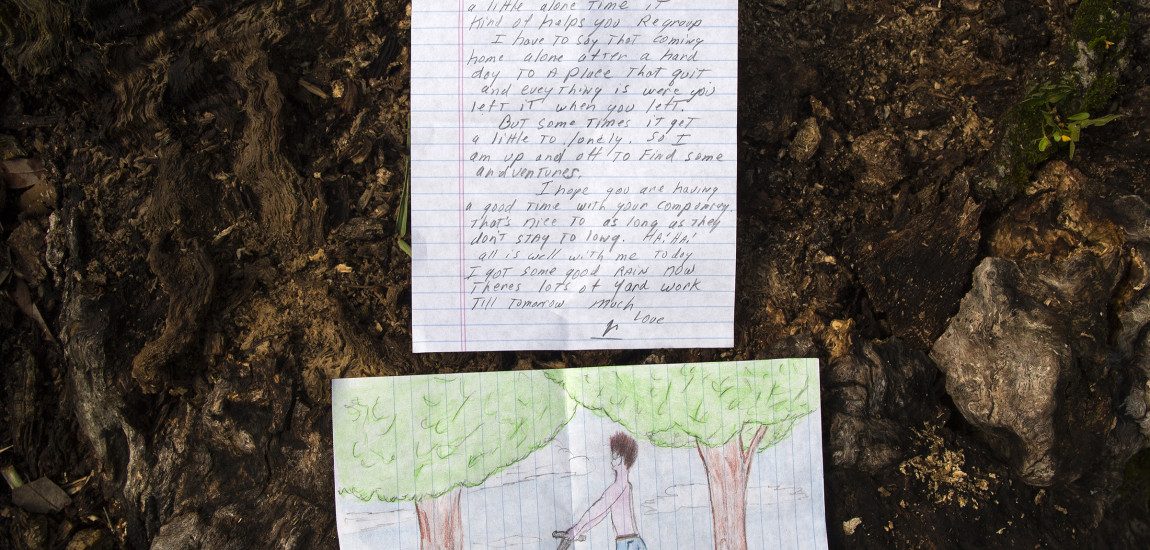Love Letters in a Tree

By Michael McFadden
Photo courtesy of Lawndale Art Center
Throughout history, lovers have exchanged letters — sometimes openly and sometimes in secret. Documentation of letters like these is nothing new. You can go online and read love letters between James Joyce and his wife Nora during his 1909 business trip to Dublin. Henry VIII’s love letters to Anne Boleyn are even kept in the Vatican Library. Currently on display at Lawndale Art Center, you can see the love letters of two Houstonians in the heartwarming yet voyeuristic exhibition “Love Letters in a Tree” by Otis Ike and Ivete Lucas.
The two artists have always used documentary photography and filmmaking to explore niche parts of our society, often growing attached to the subjects of their work. The key difference in this exhibition is that, instead of a sense of closeness between the artists and the subject, there’s a sense of distance. “This project began when Ivete and I witnessed an odd man in Broad Acres Park in Houston, TX get out of his car, walk up to an enormous burl on a dead oak tree and place something into it.” After the man left, Ike went to the tree and found a Ziploc bag buried in the burl. In it, he found two pieces of paper: a letter addressed “My Dearest J” from “V” and a drawing of a man who could be no one other than V himself.
On an almost daily basis, V and J would communicate through the decaying tree. As the two writers communicated, they displayed their ideas on love, nature, astrology, family, and a wide array of other topics through text and illustration. Like pen pals, their physically detached relationship grew over the six-month period of Ike and Lucas’s surveillance. In the beginning, the artists assumed that the relationship between the two writers was a sort of forbidden romance. Piquing Ike’s interest, it led him to begin routinely and covertly removing the letters, arranging them on the tree, and photographing them before returning everything to its place.
Walking into the exhibition, a recreation of a drawing by V greets guests. The photographs, arranged on the wall with an occasional addition of plant life seated on the frame, follow the timeline of the artists’ NSA-level observation. While it isn’t completely necessary to follow the order of the letters, it helps viewers piece together the story, or their interpretation of the story, of V and J. Aside from the two writers, no one had a clear understanding of the relationship. “They clearly love each other, but V had a distant boyfriend in Florida, and J was married.” As Ike and Lucas documented the exchange, they found that others in the neighborhood were equally intrigued. It seemed that everyone had their own mythos about the two writers and what they were doing. Some believed the lovers to be two men while others believed the tree to be a drop off point for drugs and even called the police-an interaction that V displays in one of his letters and illustrations.
Deeper into the timeline, the artists and writers alike realize that the tree is decaying and will have to come down. “Six months into photographing their letters, I noticed that the condition of the tree was deteriorating.” Ants and fungus were eating away at the burl, and it would only be a matter of time before the city would come for it. Ike and Lucas bring the exhibition to an end in two ways: First, the timeline comes to an end with the last of the letters laid out on the stump, the writers discussing where they could move to, and secondly, with the centerpiece of the exhibition. In the middle of the gallery space, the artists constructed a giant stump out of pieces of wood, which seems to be decaying itself. As you move around the photographs on the wall, a hole in the stump becomes a clear doorway, and on the inside, visitors can see the tree coming down. The sounds of the workers and the tree fill the space as the videos are projected on the installation’s interior, allowing a final voyeuristic look into the mind of the neighborhood watching the tree come down and an imagining of what the writers must have been feeling when they found the stump.
Ike’s obsession with the exchange is something we can all relate to. “Much like J must have, I craved seeing V’s drawings and learning about his life. Equally, J was a mystery.” Truly, it’s hard not to become obsessed. As much as viewers begin to feel like NSA agents inserting themselves into the personal lives of these writers, the two are so loving and adorable that stopping isn’t an option. The same is true of the artist. “Ethically and legally, it was a questionable risk to invade the privacy of the two writers, but I could not seem to stop.” As a culture, Americans thrive on hearing about the innermost secrets of others, projecting different thoughts onto situations to make them seem scandalous. The truth is that no one knows the nature of the writers’ relationship. It’s never clear whether J is a man or woman, and the writing in the letters has led some to believe that one of them might be learning disabled. From the perspective of a former ESL teacher, the two writers could be foreigners, communicating in a mutual language that isn’t either’s first. That’s the fun part of this exhibition. You build your own interpretation-your own story for these love letters.
It’s hard to say what’s happened to V and J’s exchange, but with the obvious love between these two people, it’s hard to believe that they’ve stopped writing. Perhaps, hopefully, they’ve found a new place for their letters-somewhere that affords them a little more privacy.
